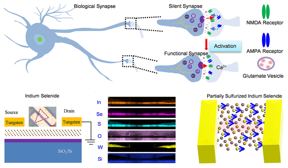Home > Press > SUTD researchers develop ultra-scalable artificial synapse
 |
| Brain-inspired device used for integrating both silent and functional synapses CREDIT SUTD |
Abstract:
A research team, led by Assistant Professor Desmond Loke from the Singapore University of Technology and Design (SUTD), has developed a new type of artificial synapse based on two-dimensional (2D) materials for highly scalable brain-inspired computing.
SUTD researchers develop ultra-scalable artificial synapse
Singapore | Posted on December 24th, 2021Brain-inspired computing, which mimics how the human brain functions, has drawn significant scientific attention because of its uses in artificial intelligence functions and low energy consumption. For brain-inspired computing to work, synapses remembering the connections between two neurons are necessary, like human brains. In developing brains, synapses can be grouped into functional synapses and silent synapses. For functional synapses, the synapses are active, while for silent synapses, the synapses are inactive under normal conditions. And, when silent synapses are activated, they can help to optimize the connections between neurons. However, as artificial synapses built on digital circuits typically occupy large spaces, there are usually limitations in terms of hardware efficiency and costs. As the human brain contains about a hundred trillion synapses, it is necessary to improve the hardware cost in order to apply it to smart portable devices and internet-of things (IoTs).
To tackle this issue, the SUTD research team mimicked behaviors of functional and silent synapses using 2D materials. Additionally, this artificial synapse demonstrates for the first time that it can be implemented with the same device that functions as both functional and silent synapses.
Assistant Prof Loke mentioned that this work can dramatically reduce the hardware costs by replacing functional and silent synapses that were based on complex digital circuits with a single device. “We have demonstrated that functional and silent synapses can be implemented using a single device.”
“By integrating functional and silent synapses into the same device using ultrathin 2D materials, the hardware cost of artificial synapses will significantly decrease, which will drive the commercialization of brain-inspired hardware.” added Assistant Prof Loke.
From the viewpoint of neurobiology, silent synapses would not generate excitatory behavior when presynaptic neurons receive continuous stimuli because they contain N-methyl-D-aspartate (NMDA) receptors, but they lack the alpha-amino-3-hydroxy-5-methyl-4-isoxazole-propionic-acid (AMPA) receptors. However, silent synapses can be activated to become functional synapses that respond to stimulations upon the insertion of AMPA receptors after consecutive stimulations. Inspired by the biological mechanism for silent synapse activation through the insertion of AMPA receptors, transformations from silent synapses to functional synapses in devices can be achieved by introducing sulphur anions in 2D indium selenide material systems. The sulphur anions in indium selenide can migrate under an electric field and exhibit functional synaptic plasticity. This device, based on a fully sulfurized type of system, show obvious memristive behavior at room temperature, which can be used to implement functional synapses. The activation of silent synapses can be demonstrated using a partially sulfurized type of system by modifying the temperature.
This research was published in ACS Applied Materials & Interfaces. The research team include Song Hao, Khin Yin Pang, Nan Wang, Huimin Li, Yu Jiang, Kian-Guan Lim and Tow-Chong Chong from SUTD, and Shuai Zhong, Xinglong Ji and Rong Zhao from Tsinghua University.
####
For more information, please click here
Contacts:
Melissa Koh
Singapore University of Technology and Design
Office: 65-649-98742
Copyright © Singapore University of Technology and Design (SUTD)
If you have a comment, please Contact us.Issuers of news releases, not 7th Wave, Inc. or Nanotechnology Now, are solely responsible for the accuracy of the content.
| Related Links |
| Related News Press |
2 Dimensional Materials
![]() NRL discovers two-dimensional waveguides February 16th, 2024
NRL discovers two-dimensional waveguides February 16th, 2024
![]() 'Sudden death' of quantum fluctuations defies current theories of superconductivity: Study challenges the conventional wisdom of superconducting quantum transitions January 12th, 2024
'Sudden death' of quantum fluctuations defies current theories of superconductivity: Study challenges the conventional wisdom of superconducting quantum transitions January 12th, 2024
Discoveries
![]() Chemical reactions can scramble quantum information as well as black holes April 5th, 2024
Chemical reactions can scramble quantum information as well as black holes April 5th, 2024
![]() New micromaterial releases nanoparticles that selectively destroy cancer cells April 5th, 2024
New micromaterial releases nanoparticles that selectively destroy cancer cells April 5th, 2024
![]() Utilizing palladium for addressing contact issues of buried oxide thin film transistors April 5th, 2024
Utilizing palladium for addressing contact issues of buried oxide thin film transistors April 5th, 2024
Announcements
![]() NRL charters Navy’s quantum inertial navigation path to reduce drift April 5th, 2024
NRL charters Navy’s quantum inertial navigation path to reduce drift April 5th, 2024
![]() Discovery points path to flash-like memory for storing qubits: Rice find could hasten development of nonvolatile quantum memory April 5th, 2024
Discovery points path to flash-like memory for storing qubits: Rice find could hasten development of nonvolatile quantum memory April 5th, 2024
Artificial Intelligence
![]() Simulating magnetization in a Heisenberg quantum spin chain April 5th, 2024
Simulating magnetization in a Heisenberg quantum spin chain April 5th, 2024
![]() Researchers’ approach may protect quantum computers from attacks March 8th, 2024
Researchers’ approach may protect quantum computers from attacks March 8th, 2024
![]() New chip opens door to AI computing at light speed February 16th, 2024
New chip opens door to AI computing at light speed February 16th, 2024
![]() HKUST researchers develop new integration technique for efficient coupling of III-V and silicon February 16th, 2024
HKUST researchers develop new integration technique for efficient coupling of III-V and silicon February 16th, 2024
|
|
||
|
|
||
| The latest news from around the world, FREE | ||
|
|
||
|
|
||
| Premium Products | ||
|
|
||
|
Only the news you want to read!
Learn More |
||
|
|
||
|
Full-service, expert consulting
Learn More |
||
|
|
||








